Lifetime Risk of Diabetes and Obesity in Metropolitan Adelaide
VerifiedAdded on 2022/12/27
|9
|2306
|67
AI Summary
This article discusses the lifetime risk of diabetes and obesity in Metropolitan Adelaide. It focuses on the population group affected by diabetes mellitus and the health priority of lowering its impact. The article also explores the barriers and enablers to health access in the area and the impact of health access on the population group. It emphasizes the importance of healthcare access for effective management and prevention of complications.
Contribute Materials
Your contribution can guide someone’s learning journey. Share your
documents today.
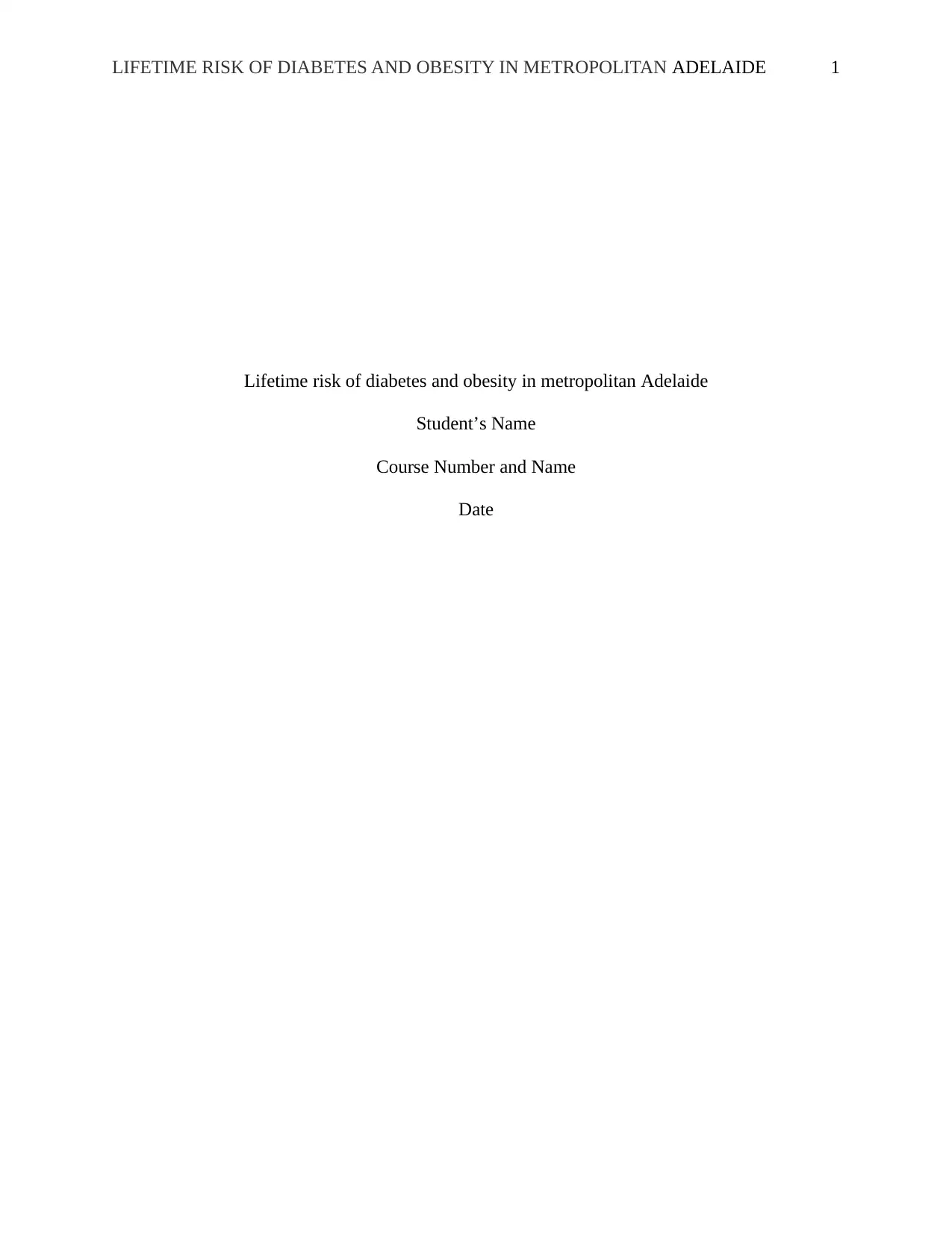
LIFETIME RISK OF DIABETES AND OBESITY IN METROPOLITAN ADELAIDE 1
Lifetime risk of diabetes and obesity in metropolitan Adelaide
Student’s Name
Course Number and Name
Date
Lifetime risk of diabetes and obesity in metropolitan Adelaide
Student’s Name
Course Number and Name
Date
Secure Best Marks with AI Grader
Need help grading? Try our AI Grader for instant feedback on your assignments.
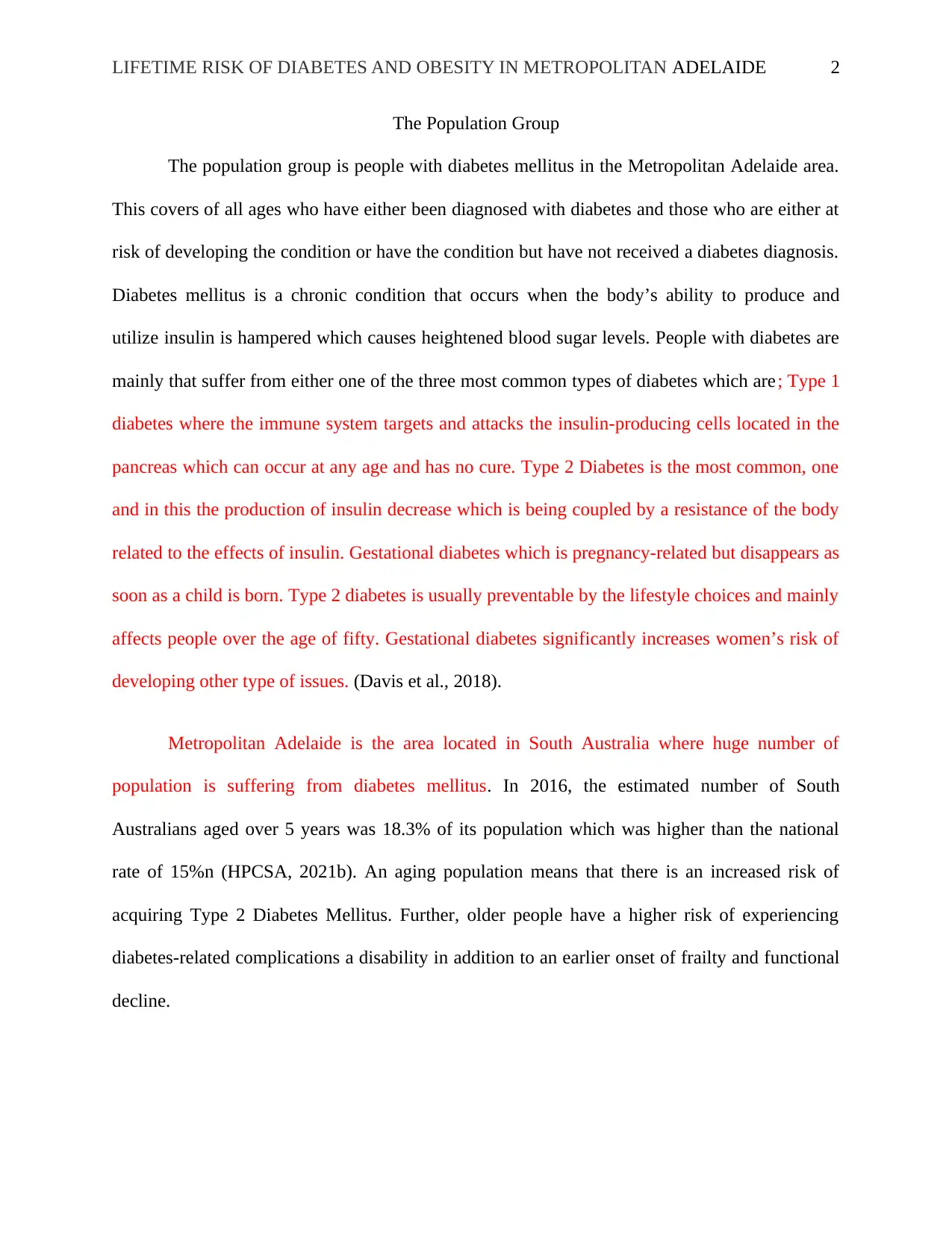
LIFETIME RISK OF DIABETES AND OBESITY IN METROPOLITAN ADELAIDE 2
The Population Group
The population group is people with diabetes mellitus in the Metropolitan Adelaide area.
This covers of all ages who have either been diagnosed with diabetes and those who are either at
risk of developing the condition or have the condition but have not received a diabetes diagnosis.
Diabetes mellitus is a chronic condition that occurs when the body’s ability to produce and
utilize insulin is hampered which causes heightened blood sugar levels. People with diabetes are
mainly that suffer from either one of the three most common types of diabetes which are; Type 1
diabetes where the immune system targets and attacks the insulin-producing cells located in the
pancreas which can occur at any age and has no cure. Type 2 Diabetes is the most common, one
and in this the production of insulin decrease which is being coupled by a resistance of the body
related to the effects of insulin. Gestational diabetes which is pregnancy-related but disappears as
soon as a child is born. Type 2 diabetes is usually preventable by the lifestyle choices and mainly
affects people over the age of fifty. Gestational diabetes significantly increases women’s risk of
developing other type of issues. (Davis et al., 2018).
Metropolitan Adelaide is the area located in South Australia where huge number of
population is suffering from diabetes mellitus. In 2016, the estimated number of South
Australians aged over 5 years was 18.3% of its population which was higher than the national
rate of 15%n (HPCSA, 2021b). An aging population means that there is an increased risk of
acquiring Type 2 Diabetes Mellitus. Further, older people have a higher risk of experiencing
diabetes-related complications a disability in addition to an earlier onset of frailty and functional
decline.
The Population Group
The population group is people with diabetes mellitus in the Metropolitan Adelaide area.
This covers of all ages who have either been diagnosed with diabetes and those who are either at
risk of developing the condition or have the condition but have not received a diabetes diagnosis.
Diabetes mellitus is a chronic condition that occurs when the body’s ability to produce and
utilize insulin is hampered which causes heightened blood sugar levels. People with diabetes are
mainly that suffer from either one of the three most common types of diabetes which are; Type 1
diabetes where the immune system targets and attacks the insulin-producing cells located in the
pancreas which can occur at any age and has no cure. Type 2 Diabetes is the most common, one
and in this the production of insulin decrease which is being coupled by a resistance of the body
related to the effects of insulin. Gestational diabetes which is pregnancy-related but disappears as
soon as a child is born. Type 2 diabetes is usually preventable by the lifestyle choices and mainly
affects people over the age of fifty. Gestational diabetes significantly increases women’s risk of
developing other type of issues. (Davis et al., 2018).
Metropolitan Adelaide is the area located in South Australia where huge number of
population is suffering from diabetes mellitus. In 2016, the estimated number of South
Australians aged over 5 years was 18.3% of its population which was higher than the national
rate of 15%n (HPCSA, 2021b). An aging population means that there is an increased risk of
acquiring Type 2 Diabetes Mellitus. Further, older people have a higher risk of experiencing
diabetes-related complications a disability in addition to an earlier onset of frailty and functional
decline.
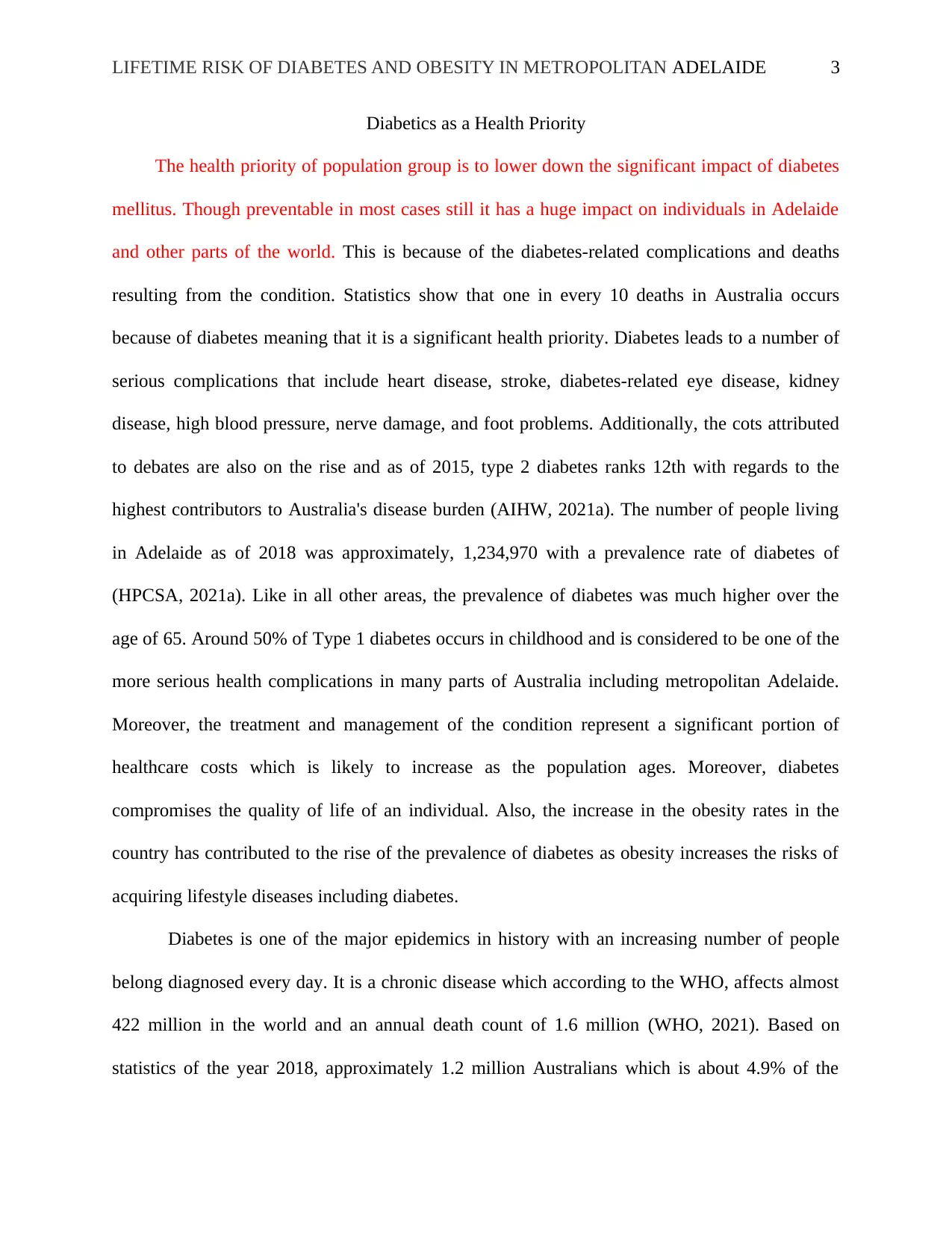
LIFETIME RISK OF DIABETES AND OBESITY IN METROPOLITAN ADELAIDE 3
Diabetics as a Health Priority
The health priority of population group is to lower down the significant impact of diabetes
mellitus. Though preventable in most cases still it has a huge impact on individuals in Adelaide
and other parts of the world. This is because of the diabetes-related complications and deaths
resulting from the condition. Statistics show that one in every 10 deaths in Australia occurs
because of diabetes meaning that it is a significant health priority. Diabetes leads to a number of
serious complications that include heart disease, stroke, diabetes-related eye disease, kidney
disease, high blood pressure, nerve damage, and foot problems. Additionally, the cots attributed
to debates are also on the rise and as of 2015, type 2 diabetes ranks 12th with regards to the
highest contributors to Australia's disease burden (AIHW, 2021a). The number of people living
in Adelaide as of 2018 was approximately, 1,234,970 with a prevalence rate of diabetes of
(HPCSA, 2021a). Like in all other areas, the prevalence of diabetes was much higher over the
age of 65. Around 50% of Type 1 diabetes occurs in childhood and is considered to be one of the
more serious health complications in many parts of Australia including metropolitan Adelaide.
Moreover, the treatment and management of the condition represent a significant portion of
healthcare costs which is likely to increase as the population ages. Moreover, diabetes
compromises the quality of life of an individual. Also, the increase in the obesity rates in the
country has contributed to the rise of the prevalence of diabetes as obesity increases the risks of
acquiring lifestyle diseases including diabetes.
Diabetes is one of the major epidemics in history with an increasing number of people
belong diagnosed every day. It is a chronic disease which according to the WHO, affects almost
422 million in the world and an annual death count of 1.6 million (WHO, 2021). Based on
statistics of the year 2018, approximately 1.2 million Australians which is about 4.9% of the
Diabetics as a Health Priority
The health priority of population group is to lower down the significant impact of diabetes
mellitus. Though preventable in most cases still it has a huge impact on individuals in Adelaide
and other parts of the world. This is because of the diabetes-related complications and deaths
resulting from the condition. Statistics show that one in every 10 deaths in Australia occurs
because of diabetes meaning that it is a significant health priority. Diabetes leads to a number of
serious complications that include heart disease, stroke, diabetes-related eye disease, kidney
disease, high blood pressure, nerve damage, and foot problems. Additionally, the cots attributed
to debates are also on the rise and as of 2015, type 2 diabetes ranks 12th with regards to the
highest contributors to Australia's disease burden (AIHW, 2021a). The number of people living
in Adelaide as of 2018 was approximately, 1,234,970 with a prevalence rate of diabetes of
(HPCSA, 2021a). Like in all other areas, the prevalence of diabetes was much higher over the
age of 65. Around 50% of Type 1 diabetes occurs in childhood and is considered to be one of the
more serious health complications in many parts of Australia including metropolitan Adelaide.
Moreover, the treatment and management of the condition represent a significant portion of
healthcare costs which is likely to increase as the population ages. Moreover, diabetes
compromises the quality of life of an individual. Also, the increase in the obesity rates in the
country has contributed to the rise of the prevalence of diabetes as obesity increases the risks of
acquiring lifestyle diseases including diabetes.
Diabetes is one of the major epidemics in history with an increasing number of people
belong diagnosed every day. It is a chronic disease which according to the WHO, affects almost
422 million in the world and an annual death count of 1.6 million (WHO, 2021). Based on
statistics of the year 2018, approximately 1.2 million Australians which is about 4.9% of the
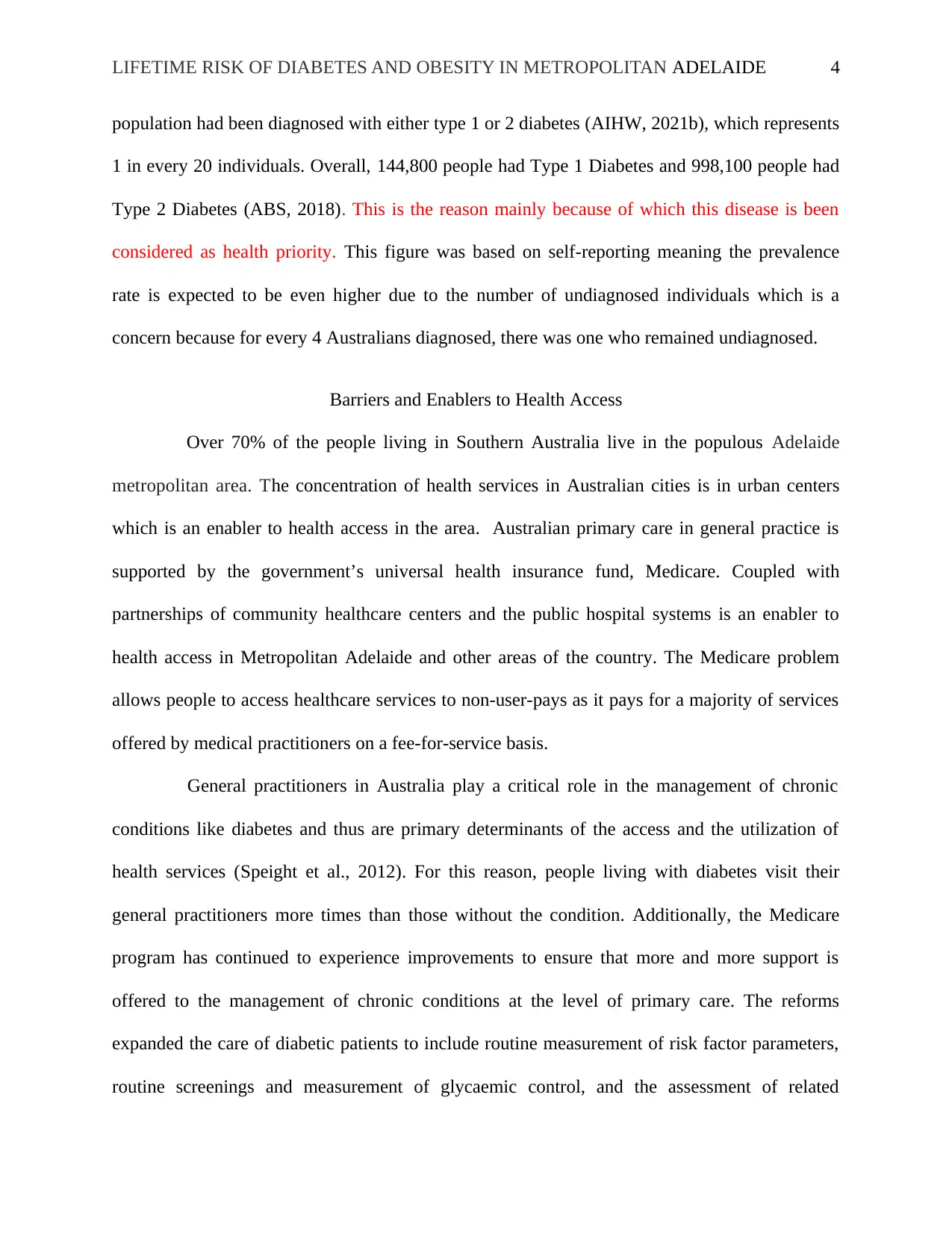
LIFETIME RISK OF DIABETES AND OBESITY IN METROPOLITAN ADELAIDE 4
population had been diagnosed with either type 1 or 2 diabetes (AIHW, 2021b), which represents
1 in every 20 individuals. Overall, 144,800 people had Type 1 Diabetes and 998,100 people had
Type 2 Diabetes (ABS, 2018). This is the reason mainly because of which this disease is been
considered as health priority. This figure was based on self-reporting meaning the prevalence
rate is expected to be even higher due to the number of undiagnosed individuals which is a
concern because for every 4 Australians diagnosed, there was one who remained undiagnosed.
Barriers and Enablers to Health Access
Over 70% of the people living in Southern Australia live in the populous Adelaide
metropolitan area. The concentration of health services in Australian cities is in urban centers
which is an enabler to health access in the area. Australian primary care in general practice is
supported by the government’s universal health insurance fund, Medicare. Coupled with
partnerships of community healthcare centers and the public hospital systems is an enabler to
health access in Metropolitan Adelaide and other areas of the country. The Medicare problem
allows people to access healthcare services to non-user-pays as it pays for a majority of services
offered by medical practitioners on a fee-for-service basis.
General practitioners in Australia play a critical role in the management of chronic
conditions like diabetes and thus are primary determinants of the access and the utilization of
health services (Speight et al., 2012). For this reason, people living with diabetes visit their
general practitioners more times than those without the condition. Additionally, the Medicare
program has continued to experience improvements to ensure that more and more support is
offered to the management of chronic conditions at the level of primary care. The reforms
expanded the care of diabetic patients to include routine measurement of risk factor parameters,
routine screenings and measurement of glycaemic control, and the assessment of related
population had been diagnosed with either type 1 or 2 diabetes (AIHW, 2021b), which represents
1 in every 20 individuals. Overall, 144,800 people had Type 1 Diabetes and 998,100 people had
Type 2 Diabetes (ABS, 2018). This is the reason mainly because of which this disease is been
considered as health priority. This figure was based on self-reporting meaning the prevalence
rate is expected to be even higher due to the number of undiagnosed individuals which is a
concern because for every 4 Australians diagnosed, there was one who remained undiagnosed.
Barriers and Enablers to Health Access
Over 70% of the people living in Southern Australia live in the populous Adelaide
metropolitan area. The concentration of health services in Australian cities is in urban centers
which is an enabler to health access in the area. Australian primary care in general practice is
supported by the government’s universal health insurance fund, Medicare. Coupled with
partnerships of community healthcare centers and the public hospital systems is an enabler to
health access in Metropolitan Adelaide and other areas of the country. The Medicare problem
allows people to access healthcare services to non-user-pays as it pays for a majority of services
offered by medical practitioners on a fee-for-service basis.
General practitioners in Australia play a critical role in the management of chronic
conditions like diabetes and thus are primary determinants of the access and the utilization of
health services (Speight et al., 2012). For this reason, people living with diabetes visit their
general practitioners more times than those without the condition. Additionally, the Medicare
program has continued to experience improvements to ensure that more and more support is
offered to the management of chronic conditions at the level of primary care. The reforms
expanded the care of diabetic patients to include routine measurement of risk factor parameters,
routine screenings and measurement of glycaemic control, and the assessment of related
Secure Best Marks with AI Grader
Need help grading? Try our AI Grader for instant feedback on your assignments.
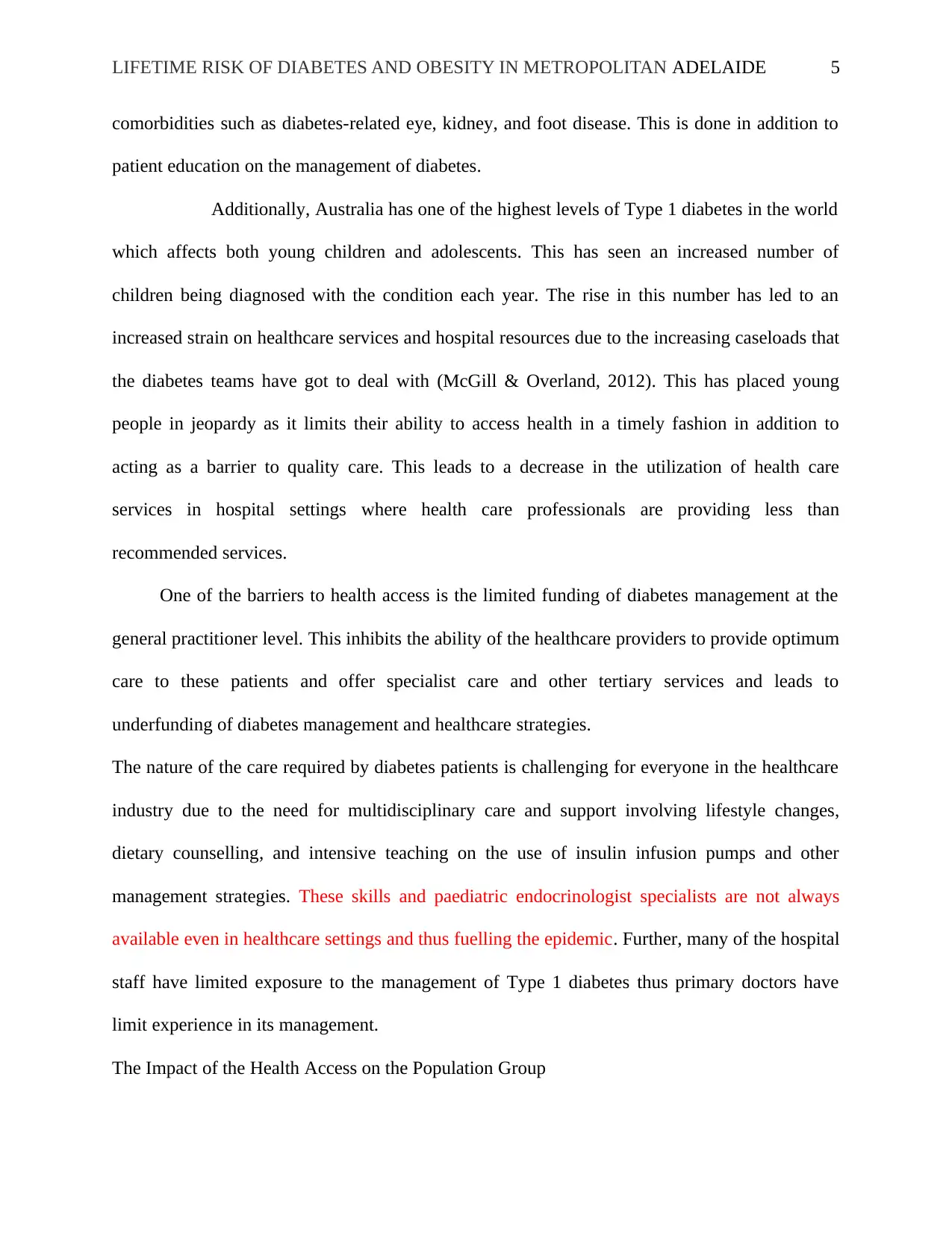
LIFETIME RISK OF DIABETES AND OBESITY IN METROPOLITAN ADELAIDE 5
comorbidities such as diabetes-related eye, kidney, and foot disease. This is done in addition to
patient education on the management of diabetes.
Additionally, Australia has one of the highest levels of Type 1 diabetes in the world
which affects both young children and adolescents. This has seen an increased number of
children being diagnosed with the condition each year. The rise in this number has led to an
increased strain on healthcare services and hospital resources due to the increasing caseloads that
the diabetes teams have got to deal with (McGill & Overland, 2012). This has placed young
people in jeopardy as it limits their ability to access health in a timely fashion in addition to
acting as a barrier to quality care. This leads to a decrease in the utilization of health care
services in hospital settings where health care professionals are providing less than
recommended services.
One of the barriers to health access is the limited funding of diabetes management at the
general practitioner level. This inhibits the ability of the healthcare providers to provide optimum
care to these patients and offer specialist care and other tertiary services and leads to
underfunding of diabetes management and healthcare strategies.
The nature of the care required by diabetes patients is challenging for everyone in the healthcare
industry due to the need for multidisciplinary care and support involving lifestyle changes,
dietary counselling, and intensive teaching on the use of insulin infusion pumps and other
management strategies. These skills and paediatric endocrinologist specialists are not always
available even in healthcare settings and thus fuelling the epidemic. Further, many of the hospital
staff have limited exposure to the management of Type 1 diabetes thus primary doctors have
limit experience in its management.
The Impact of the Health Access on the Population Group
comorbidities such as diabetes-related eye, kidney, and foot disease. This is done in addition to
patient education on the management of diabetes.
Additionally, Australia has one of the highest levels of Type 1 diabetes in the world
which affects both young children and adolescents. This has seen an increased number of
children being diagnosed with the condition each year. The rise in this number has led to an
increased strain on healthcare services and hospital resources due to the increasing caseloads that
the diabetes teams have got to deal with (McGill & Overland, 2012). This has placed young
people in jeopardy as it limits their ability to access health in a timely fashion in addition to
acting as a barrier to quality care. This leads to a decrease in the utilization of health care
services in hospital settings where health care professionals are providing less than
recommended services.
One of the barriers to health access is the limited funding of diabetes management at the
general practitioner level. This inhibits the ability of the healthcare providers to provide optimum
care to these patients and offer specialist care and other tertiary services and leads to
underfunding of diabetes management and healthcare strategies.
The nature of the care required by diabetes patients is challenging for everyone in the healthcare
industry due to the need for multidisciplinary care and support involving lifestyle changes,
dietary counselling, and intensive teaching on the use of insulin infusion pumps and other
management strategies. These skills and paediatric endocrinologist specialists are not always
available even in healthcare settings and thus fuelling the epidemic. Further, many of the hospital
staff have limited exposure to the management of Type 1 diabetes thus primary doctors have
limit experience in its management.
The Impact of the Health Access on the Population Group
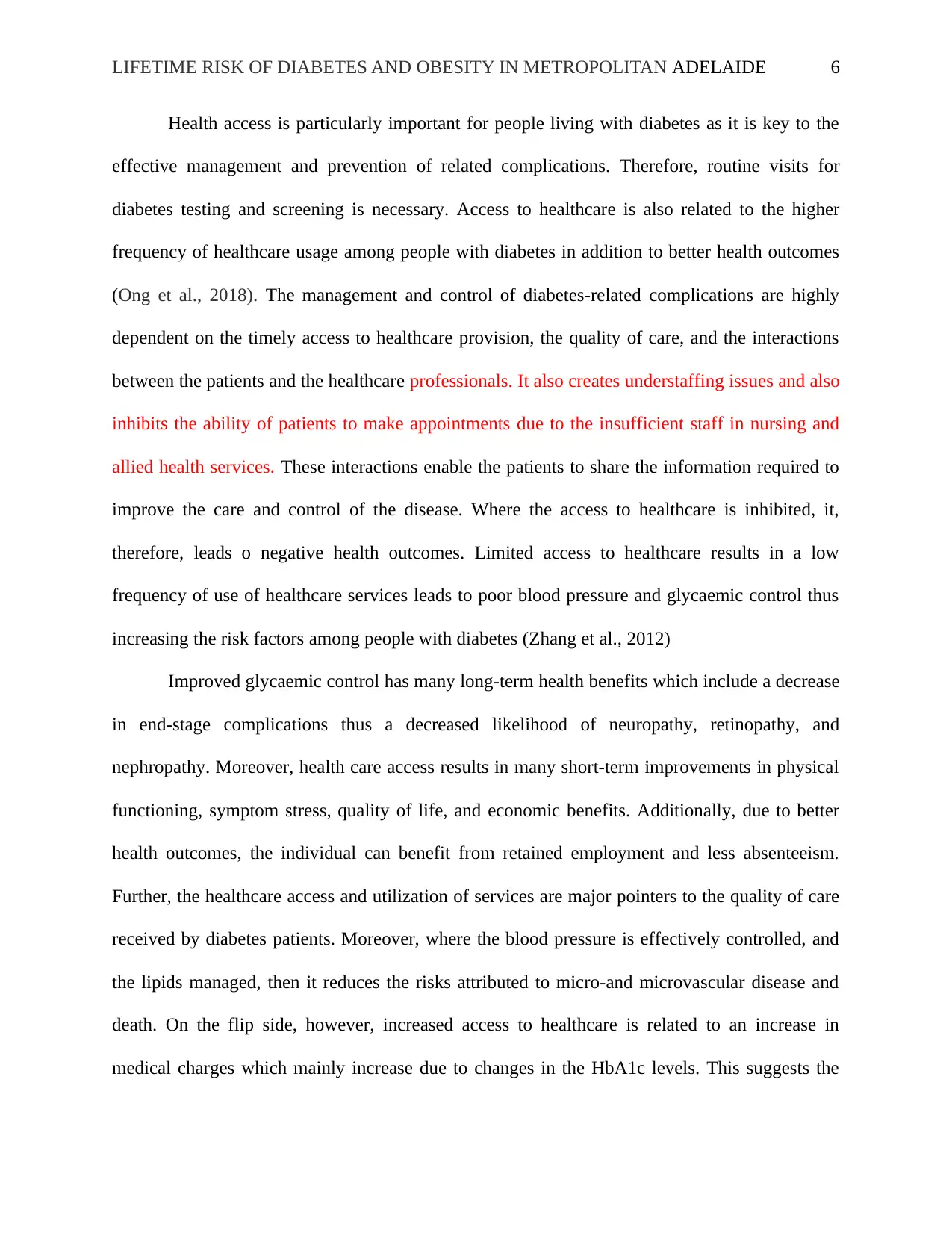
LIFETIME RISK OF DIABETES AND OBESITY IN METROPOLITAN ADELAIDE 6
Health access is particularly important for people living with diabetes as it is key to the
effective management and prevention of related complications. Therefore, routine visits for
diabetes testing and screening is necessary. Access to healthcare is also related to the higher
frequency of healthcare usage among people with diabetes in addition to better health outcomes
(Ong et al., 2018). The management and control of diabetes-related complications are highly
dependent on the timely access to healthcare provision, the quality of care, and the interactions
between the patients and the healthcare professionals. It also creates understaffing issues and also
inhibits the ability of patients to make appointments due to the insufficient staff in nursing and
allied health services. These interactions enable the patients to share the information required to
improve the care and control of the disease. Where the access to healthcare is inhibited, it,
therefore, leads o negative health outcomes. Limited access to healthcare results in a low
frequency of use of healthcare services leads to poor blood pressure and glycaemic control thus
increasing the risk factors among people with diabetes (Zhang et al., 2012)
Improved glycaemic control has many long-term health benefits which include a decrease
in end-stage complications thus a decreased likelihood of neuropathy, retinopathy, and
nephropathy. Moreover, health care access results in many short-term improvements in physical
functioning, symptom stress, quality of life, and economic benefits. Additionally, due to better
health outcomes, the individual can benefit from retained employment and less absenteeism.
Further, the healthcare access and utilization of services are major pointers to the quality of care
received by diabetes patients. Moreover, where the blood pressure is effectively controlled, and
the lipids managed, then it reduces the risks attributed to micro-and microvascular disease and
death. On the flip side, however, increased access to healthcare is related to an increase in
medical charges which mainly increase due to changes in the HbA1c levels. This suggests the
Health access is particularly important for people living with diabetes as it is key to the
effective management and prevention of related complications. Therefore, routine visits for
diabetes testing and screening is necessary. Access to healthcare is also related to the higher
frequency of healthcare usage among people with diabetes in addition to better health outcomes
(Ong et al., 2018). The management and control of diabetes-related complications are highly
dependent on the timely access to healthcare provision, the quality of care, and the interactions
between the patients and the healthcare professionals. It also creates understaffing issues and also
inhibits the ability of patients to make appointments due to the insufficient staff in nursing and
allied health services. These interactions enable the patients to share the information required to
improve the care and control of the disease. Where the access to healthcare is inhibited, it,
therefore, leads o negative health outcomes. Limited access to healthcare results in a low
frequency of use of healthcare services leads to poor blood pressure and glycaemic control thus
increasing the risk factors among people with diabetes (Zhang et al., 2012)
Improved glycaemic control has many long-term health benefits which include a decrease
in end-stage complications thus a decreased likelihood of neuropathy, retinopathy, and
nephropathy. Moreover, health care access results in many short-term improvements in physical
functioning, symptom stress, quality of life, and economic benefits. Additionally, due to better
health outcomes, the individual can benefit from retained employment and less absenteeism.
Further, the healthcare access and utilization of services are major pointers to the quality of care
received by diabetes patients. Moreover, where the blood pressure is effectively controlled, and
the lipids managed, then it reduces the risks attributed to micro-and microvascular disease and
death. On the flip side, however, increased access to healthcare is related to an increase in
medical charges which mainly increase due to changes in the HbA1c levels. This suggests the

LIFETIME RISK OF DIABETES AND OBESITY IN METROPOLITAN ADELAIDE 7
need for adequate investments and funding of the clinical systems to ensure that diabetes care is
improved for the benefit of both the patients and the payers.
need for adequate investments and funding of the clinical systems to ensure that diabetes care is
improved for the benefit of both the patients and the payers.
Paraphrase This Document
Need a fresh take? Get an instant paraphrase of this document with our AI Paraphraser
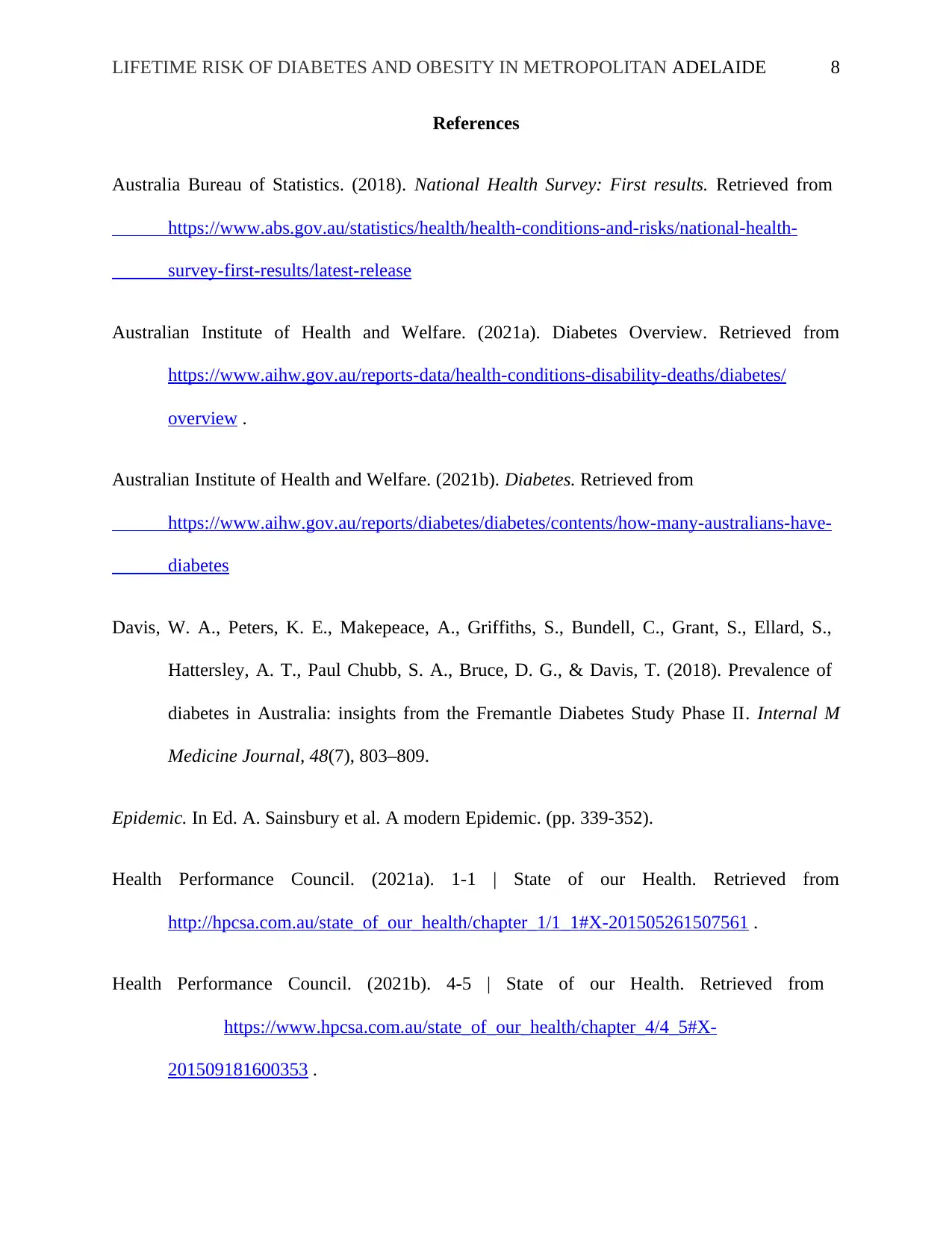
LIFETIME RISK OF DIABETES AND OBESITY IN METROPOLITAN ADELAIDE 8
References
Australia Bureau of Statistics. (2018). National Health Survey: First results. Retrieved from
https://www.abs.gov.au/statistics/health/health-conditions-and-risks/national-health-
survey-first-results/latest-release
Australian Institute of Health and Welfare. (2021a). Diabetes Overview. Retrieved from
https://www.aihw.gov.au/reports-data/health-conditions-disability-deaths/diabetes/
overview .
Australian Institute of Health and Welfare. (2021b). Diabetes. Retrieved from
https://www.aihw.gov.au/reports/diabetes/diabetes/contents/how-many-australians-have-
diabetes
Davis, W. A., Peters, K. E., Makepeace, A., Griffiths, S., Bundell, C., Grant, S., Ellard, S.,
Hattersley, A. T., Paul Chubb, S. A., Bruce, D. G., & Davis, T. (2018). Prevalence of
diabetes in Australia: insights from the Fremantle Diabetes Study Phase II. Internal M
Medicine Journal, 48(7), 803–809.
Epidemic. In Ed. A. Sainsbury et al. A modern Epidemic. (pp. 339-352).
Health Performance Council. (2021a). 1-1 | State of our Health. Retrieved from
http://hpcsa.com.au/state_of_our_health/chapter_1/1_1#X-201505261507561 .
Health Performance Council. (2021b). 4-5 | State of our Health. Retrieved from
https://www.hpcsa.com.au/state_of_our_health/chapter_4/4_5#X-
201509181600353 .
References
Australia Bureau of Statistics. (2018). National Health Survey: First results. Retrieved from
https://www.abs.gov.au/statistics/health/health-conditions-and-risks/national-health-
survey-first-results/latest-release
Australian Institute of Health and Welfare. (2021a). Diabetes Overview. Retrieved from
https://www.aihw.gov.au/reports-data/health-conditions-disability-deaths/diabetes/
overview .
Australian Institute of Health and Welfare. (2021b). Diabetes. Retrieved from
https://www.aihw.gov.au/reports/diabetes/diabetes/contents/how-many-australians-have-
diabetes
Davis, W. A., Peters, K. E., Makepeace, A., Griffiths, S., Bundell, C., Grant, S., Ellard, S.,
Hattersley, A. T., Paul Chubb, S. A., Bruce, D. G., & Davis, T. (2018). Prevalence of
diabetes in Australia: insights from the Fremantle Diabetes Study Phase II. Internal M
Medicine Journal, 48(7), 803–809.
Epidemic. In Ed. A. Sainsbury et al. A modern Epidemic. (pp. 339-352).
Health Performance Council. (2021a). 1-1 | State of our Health. Retrieved from
http://hpcsa.com.au/state_of_our_health/chapter_1/1_1#X-201505261507561 .
Health Performance Council. (2021b). 4-5 | State of our Health. Retrieved from
https://www.hpcsa.com.au/state_of_our_health/chapter_4/4_5#X-
201509181600353 .
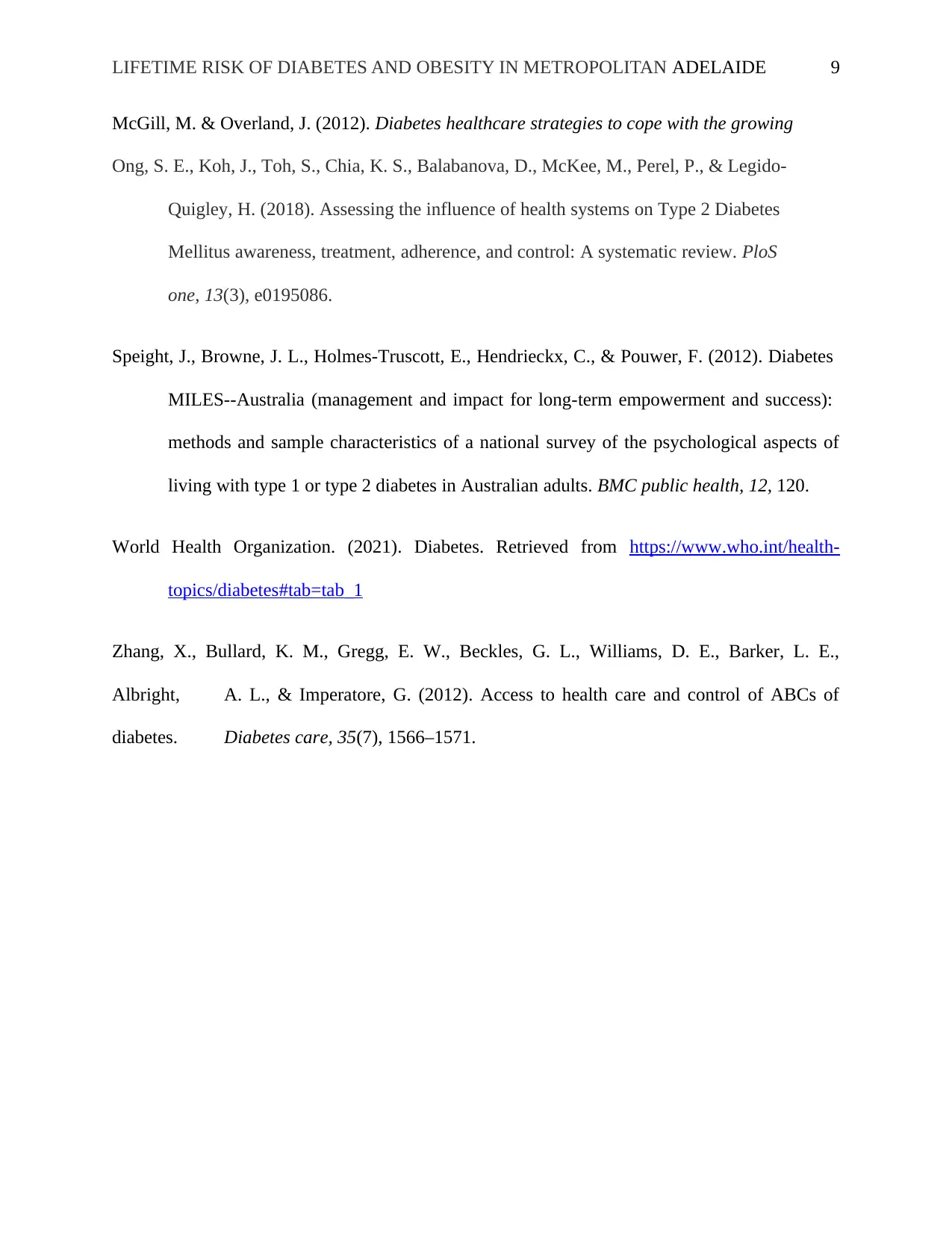
LIFETIME RISK OF DIABETES AND OBESITY IN METROPOLITAN ADELAIDE 9
McGill, M. & Overland, J. (2012). Diabetes healthcare strategies to cope with the growing
Ong, S. E., Koh, J., Toh, S., Chia, K. S., Balabanova, D., McKee, M., Perel, P., & Legido-
Quigley, H. (2018). Assessing the influence of health systems on Type 2 Diabetes
Mellitus awareness, treatment, adherence, and control: A systematic review. PloS
one, 13(3), e0195086.
Speight, J., Browne, J. L., Holmes-Truscott, E., Hendrieckx, C., & Pouwer, F. (2012). Diabetes
MILES--Australia (management and impact for long-term empowerment and success):
methods and sample characteristics of a national survey of the psychological aspects of
living with type 1 or type 2 diabetes in Australian adults. BMC public health, 12, 120.
World Health Organization. (2021). Diabetes. Retrieved from https://www.who.int/health-
topics/diabetes#tab=tab_1
Zhang, X., Bullard, K. M., Gregg, E. W., Beckles, G. L., Williams, D. E., Barker, L. E.,
Albright, A. L., & Imperatore, G. (2012). Access to health care and control of ABCs of
diabetes. Diabetes care, 35(7), 1566–1571.
McGill, M. & Overland, J. (2012). Diabetes healthcare strategies to cope with the growing
Ong, S. E., Koh, J., Toh, S., Chia, K. S., Balabanova, D., McKee, M., Perel, P., & Legido-
Quigley, H. (2018). Assessing the influence of health systems on Type 2 Diabetes
Mellitus awareness, treatment, adherence, and control: A systematic review. PloS
one, 13(3), e0195086.
Speight, J., Browne, J. L., Holmes-Truscott, E., Hendrieckx, C., & Pouwer, F. (2012). Diabetes
MILES--Australia (management and impact for long-term empowerment and success):
methods and sample characteristics of a national survey of the psychological aspects of
living with type 1 or type 2 diabetes in Australian adults. BMC public health, 12, 120.
World Health Organization. (2021). Diabetes. Retrieved from https://www.who.int/health-
topics/diabetes#tab=tab_1
Zhang, X., Bullard, K. M., Gregg, E. W., Beckles, G. L., Williams, D. E., Barker, L. E.,
Albright, A. L., & Imperatore, G. (2012). Access to health care and control of ABCs of
diabetes. Diabetes care, 35(7), 1566–1571.
1 out of 9
Related Documents
Your All-in-One AI-Powered Toolkit for Academic Success.
+13062052269
info@desklib.com
Available 24*7 on WhatsApp / Email
![[object Object]](/_next/static/media/star-bottom.7253800d.svg)
Unlock your academic potential
© 2024 | Zucol Services PVT LTD | All rights reserved.





